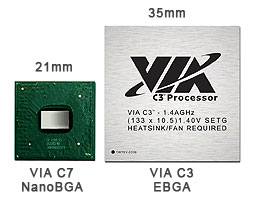Via debuts “carbon-free” desktop CPU
Sep 13, 2006 — by LinuxDevices Staff — from the LinuxDevices Archive — 9 views Via is shipping a Linux-friendly x86-compatible desktop processor, accompanied by a “Clean Computing Initiative” aimed at offsetting the chip's environmental cost. The C7-D clocks at 1.5GHz or 1.8GHz, and is shipping in an RoHS-compliant 21mm-square package.
Via is shipping a Linux-friendly x86-compatible desktop processor, accompanied by a “Clean Computing Initiative” aimed at offsetting the chip's environmental cost. The C7-D clocks at 1.5GHz or 1.8GHz, and is shipping in an RoHS-compliant 21mm-square package.
digg this story |
Via calls the C7-D the first “carbon-free” desktop processor, promising that atmospheric carbon released during generation of the power needed to run the chip throughout its expected lifecycle will be offset by regional conservation, reforestation, and energy programs initiated or contributed to by Via. The “initial offsets” for the C7-D will be worked out in cooperation with Carbon Footprint, a U.K. based “carbon footprint management specialist,” Via says.
Additionally, Via says it will work with partners to build, certify, and promote carbon-free components, as well as entire carbon-free PCs.
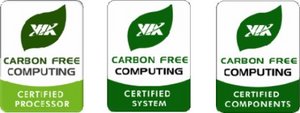
Clean Computing Initiative certifications
World's most energy-efficient desktop processor?
At 1.8GHz, the C7-D has a THD (thermal design power, aka maximum power dissipation) of 20 Watts. This makes the chip far and away the most power-hungry in Via's C7 line, which also includes the C7-M and ULV C7-M. The latter chip dissipates a max of just 7.5Watts, when clocked at 1.5GHz — just under the generally accepted practical limit for passive cooling (fanless designs). Fanless designs save even more power, obviously, by eliminating fans.
Still, compared to x86-compatible desktop processors from mainstream processor vendors such as Intel and AMD, the C7-D is downright parsimonious. To show off the chip's frugality, Via created an artificial “TreeMark” benchmark (methodology chart here; source: Via) aimed at calculating the total number of trees needed to sequester the carbon released as a result of the chip's expected lifetime operation. The chart below compares the C7-D to mainstream x86 processors from competitors Intel and AMD.
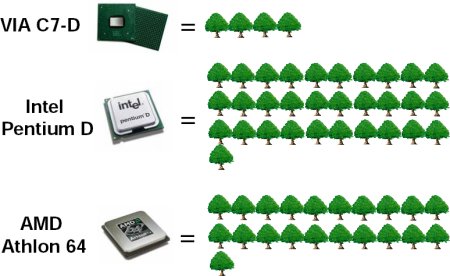
“TreeMark” results for various x86 desktop processors
(Source: Via)
Additional touted environmental benefits of the C7-D include quieter operation due to lower cooling requirements; lower air conditioning load, due to lessened heat output; and, better compatibility with solar and other alternative energy sources. Additionally, the C7-D chip is said to comply with RoHS requirements that recently went into effect in the European Union.
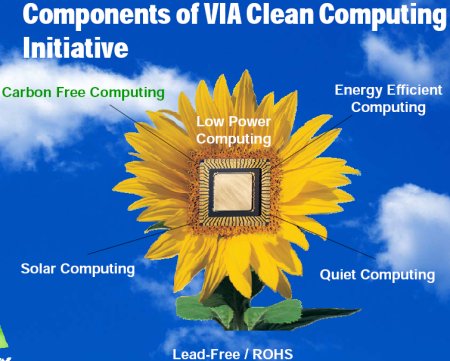
Aspects of Via's clean Computing initiative
Source: Via
While Via has long touted the energy efficiency of its processors, competitors AMD and Intel are recent converts to “performance-per-Watt” thinking as well. Intel CEO Paul Otellini made energy efficiency the focus of his keynote address at this year's Spring Intel Developer Forum, promising a 10-fold efficiency boost in forthcoming chip architectures.
AMD, meanwhile, is currently shipping “energy efficient” desktop chip models that typically draw 65 Watts, instead of 85 Watts. Additionally, the company offers “energy efficient, small form factor” models rated at 35 Watts, although only the single-core Sempron model in this category appears to be shipping — the long-awaited, 35 Watt, dual-core Athlon64 X2 3800+ model is expected to ship to PC-makers in time to go into holiday-season PCs, according to an AMD spokesperson who declined to be named, or to comment on availability of the retail version.
More about the C7-D
The C7-D is fabricated on IBM's 90nm process technology, and is based on the same “Esther” core used in other C7 chips. When the C7 was announced, the founder of Via's Austin, Texas-based Centaur processor division, Glenn Henry, called the Esther design “the embodiment of my vision for a cool, secure, and versatile processor that will take the X86 platform to the next level.”
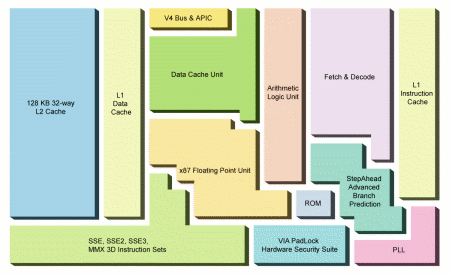
Via's C7 architecture
In addition to its power efficiency, the C7-D boasts an unusually small, 21mm-square nanoBGA package that is much smaller than the 35mm-square package housing the C3s used in most of Via's currently shipping mini-ITX boards. The C7-D's smaller size could help it fit into ultra-small form factor computers, such as Via's tiny, nano-ITX motherboards.
Meanwhile, for ultra-small PCs that run on batteries (e.g., UMPCs), Via offers the more highly integrated Vx700 and CoreFusion chipsets, as well as the more traditional ULV C7-M.
The C7, in a nano-BGA package option, is considerably smaller than the C3
Additional touted C7-D features include:
- StepAhead Advanced Branch Prediction
- Sixteen pipeline stages
- Support for SSE2 and the advanced SSE3 multimedia 3D instruction sets
- Full-speed Floating Point Unit (FPU)
- Efficiency-enhanced 128KB full-speed exclusive L2 cache with 32-way associativity for memory optimization
- PadLock Suite provides on-die hardware acceleration of key cryptographic operations
- SHA-1 and SHA-256 hashing for secure message digests
- Hardware-based Montgomery Multiplier supporting key sizes up to 32K, to accelerate public key cryptography such as RSA
- Execute protection (NX), used in Microsoft Windows XP/SP2 to provide protection from malicious software such as worms and viruses
The C7-D is supported by a CN700 chipset, which began sampling late last year. The CN700 supports DDR2 400/533 RAM, and has a 533MHz frontside bus. The chipset integrates a UniChrome Pro IGP graphics processor featuring MPEG-2 hardware acceleration, “Chromotion CE” video smoother, and DuoView+ dual monitor support. It also offers integrated 6-channel audio, along with an audiophile-grade sound-chip option when combined with Via's Linux-friendly Envy24 sound chip.
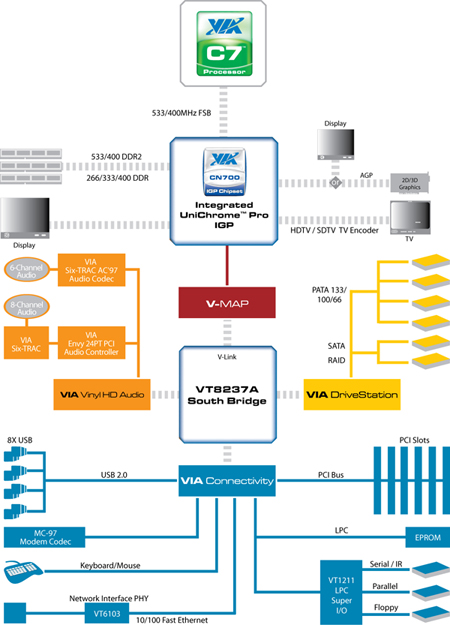
Via's CN700 desktop chipset architecture
Richard Brown, VP of Marketing at Via, stated, “VIA is very excited about contributing to projects around the world that will improve the quality of our environment, and enable us as a company to give back.”
John Buckley, managing director at Carbon Footprint, added, “Around the world we are seeing a growing interest from companies and individuals looking to 'do their bit' in reducing their carbon footprint. Products such as the VIA C7-D processor are certainly a step in the right direction.”
Availability
The C7-D is available now, packaged in a 21mm nanoBGA, and clocked at 1.5GHz or 1.8GHz.
Additional details about Via's Clean Computing Initiative can be found here.
This article was originally published on LinuxDevices.com and has been donated to the open source community by QuinStreet Inc. Please visit LinuxToday.com for up-to-date news and articles about Linux and open source.
